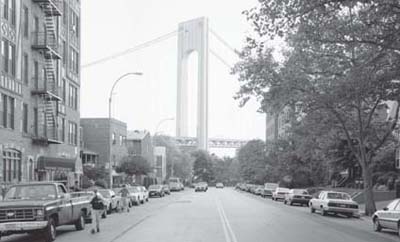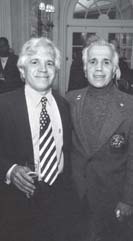PETER SPANAKOS TAUGHT IN THE NEW YORK CITY PUBLIC school system from 1964 until 1991, when he was offered early retirement and took it. Spanakos began his career during a time when blacks began moving into the city in large numbers, and he saw the animosity that developed between the whites and blacks. By the time he retired, he saw, much of the hatred had faded.
PETER SPANAKOS “I went to New York Law School in 1960. By then I had three brothers practicing. One of my professors was Roy Cohn. He taught for one hour a week. He needed the title. He had a Cadillac limo, and the engine was always running. He taught criminal law techniques.
“Mario Biaggi, a very powerful man in the police force [Biaggi retired from the NYPD in 1965 as the most decorated cop in the country], was sitting next to me. When he got out, they made a special law for him saying he didn’t have to go to college to get his law degree.
“The first day Cohn came into class, he said, ‘Listen guys, no one fails in my class.’ We all gave him a standing ovation. He said, ‘Everyone starts with a B and up. And Mario, you don’t have to worry about anything.’

The Verrazano Bridge changed the skyline of southwestern Brooklyn. Library of Congress
“Roy was gay, and he came down with AIDS. He was a very pleasant guy, but he was as fucked up as they come.
“I hated law school. I just hated the concept of a guy coming in, guilty as sin, and I have to make up lies and excuses to get him out of it. If you do something wrong, you should be punished. When later on I was a dean and a drug counselor in the public schools, kids would come to me and say, ‘Get me out of this.’
“I’d say, ‘I’m not getting you out of anything. Take your punishment like a man. Don’t come looking for me to bail you out.’
“I started working in the schools in 1964 when I was still in law school. I was called an attendance teacher, but I worked as a truant officer, and then I was assigned to one of the ‘600’ schools, which were the worst schools in the city. When they kicked you out of all the other schools, you went to a ‘600’ school.
“I got married in 1966, and in 1967 I bought my home in Sea Gate. Then I started teaching at schools in Coney Island, because it was a shorter commute.
“When I was in high school in the 1950s, we didn’t have racial conflict, because we had de facto segregation in the neighborhoods. But as the urban blight spread from neighborhoods, people were intimidated. I remember my neighbors were the first Jewish family to sell out, and then, within a year, the whole five-or six-block radius turned black. This happened in East New York, Brownsville, Bedford-Stuyvesant, areas that had good housing stock.
“Back in the ’50s, in the school system we had a box for ‘other’ in the ‘race’ category. Which back then was for ‘miscellaneous.’ Over the years, ‘other’ turned out to be whites. As the whites left, they were replaced by Hispanics, who were primarily Puerto Rican, and blacks. Later on came the Cubans and Dominicans. The Verrazano Bridge opened in 1964, and whites went to Staten Island.
“The Brooklyn economy also played a role in the white flight. Red Hook had three going factories that paid very, very well in the 1950s. There was White Rock soda, a sugar factory, and a coffee factory. They couldn’t fill up the jobs fast enough. I worked there during the summers in the 1950s. But then Red Hook started dying in the 1960s, and all the companies moved out. Once you lost that economic base in Red Hook, you lost a lot of people. As the city filled up the projects and made them bigger and bigger, you just intimidated more white people to leave.
“The Red Hook projects used to have a very good screening committee. If you wanted to live there you couldn’t have a felon in the family. You had to have an intact family. Your kids couldn’t have records. About 1966 John Lindsay, that putz, came in, and he wiped out all the committees. He was pushing to be the black man’s representative, and, unfortunately, the instant exodus from the projects was devastating. Even the blacks didn’t want to live with the blacks who came in there. They wanted to live in an integrated community. But it turned just the opposite.
“The parents felt intimidated sending their kids to the public schools, so if they wanted to stay in the city, the ones who could afford it sent them to private or parochial schools. They used to sell homes in the Catholic areas by the parish. If you had a good parish, a good parochial school, that was a big selling point for your house.
“In the 1970s we literally had to give away our home on 584 Court Street, a six-family home over the restaurant. The banks, the bastards, did what is called ‘redlining.’ Irrespective of the merits of your house or your credit, if the house fell into a certain area, they were not going to give you a mortgage, and insurance companies at the same time cut back. We had insurance for thirty years, never filed a claim, and they dropped us. So all these things were putting pressure on the whites to get out. The speculators did very well. Sea Gate had the same problem in the 1960s and 1970s. You didn’t sell your house. You gave it away. This was a blight and a curse on a lot of neighborhoods.
“I can remember a famous black doctor in Crown Heights. He had a beautiful home on President Street. In fact, the orthodox Jews would throw rocks at him when he drove on the Shabbat. The doctor put the house up for sale, and a Jewish guy wanted to buy it. The other blacks told him, ‘You’re not respecting us. You’re selling the fucking Jews your house.’ So he sold it to a black guy for $35,000 less, and that black guy then took the contract, walked to the office next door, and he resold the house to the Jews.
“Everybody was hustling, wheeling and dealing.
“The Coney Island school I taught in was rough, because we had kids from the Coney Island projects and the Marlboro projects. I began at PS 288 on West 25th Street between Mermaid and Surf Avenues on Coney Island in 1971. I was impressed with a kid, Eric Marbury, the oldest brother of Stephon, the pro basketball player. Eric was a talented kid, and I loved him. I said, ‘You’re amazing. You remind me of this kid Cassius Clay.’ But Eric was cursing a lot, so I called his parents in for a conference.
“I said, ‘I like Eric a lot but every word is m-f. I can’t tolerate it in my classroom.’
“The father got up and he said to me, ‘That’s what’s wrong with you white guys. You don’t understand how we talk at home.’
“I said, ‘Sir, whatever you do at home is your business. When you come to school, it’s my business. I’m telling you as a friend, he’s got to cool it.’ The mother, the class act of the family, a sweetheart, got up and she said to her husband, ‘You shut up. Mr. Spanakos, you won’t have that problem again.’
“Eric was a leader. One afternoon he was about to get involved in something he shouldn’t, with a gang of kids who surrounded the both of us. I grabbed him, marched him through the group, and I took him in my car and took him to my home.
“The next day a male teacher came up to me.
“‘You’re a schmuck,’ he said.
“‘Why?’
“‘You got involved in something you shouldn’t have.’
“I said, ‘When those kids were surrounding me, I saw you guys walk past me. No one helped me out, and I don’t appreciate that.’
“My teacher friend said, ‘Peter, look, you took this black kid home. What would have happened if the black kid told his parents you touched him?’
“I said, ‘What are you talking about?’ Then I thought about it. I had no authority to take him home. If he had said I had touched him, I would have been out on my ass. And that happens all the time today. Kids make up all sorts of stuff. Fortunately, Eric wasn’t that type of a kid.
“In the mid-1970s I became a counselor at Seth Low Junior High School. The animosity between the blacks and the Irish and the Italians was really bad at the time.
“I told the black kids who went there, ‘Look, this is the radius. You can’t go more than two blocks past the school.’
“‘What are you talking about?’
“‘It’s an Italian neighborhood,’ I said. ‘You’re from Coney Island Avenue and Marlborough.’
“They didn’t heed my warning. After a few months they got their courage up, and during lunch hour they went three blocks, and the Italian kids beat them with their bats. They were bleeding like pigs.
“I said to them, ‘It’s a sad commentary, but there are different parts of America, like Bensonhurst, when you’re not in America. You can’t walk down Avenue U. Hopefully this will change, but right now this is reality. It’s how it’s going to be.’
“This was a period when the city was trying to push integration, and kids from the projects were bused in. The buses had a two-car police escort, one in front, one in back.
“Today blacks freely walk up and down Avenue U. They come into the gym. They come into the school. You don’t have as much ugliness today as we had back then.
“Things change. Back then the Puerto Rican mothers used to go nuts when their daughters were dating blacks. Today they date, and it isn’t an issue.
“The Puerto Ricans and the Dominicans hate each other. We didn’t have problems with Dominicans, because they didn’t come into Brooklyn. Now we’re getting Asian kids, Chinese and Korean kids, and they are forming their own little gangs. They are all wannabees, and that’s an issue we’re having, but we don’t have the black-white racial problems we had in the 1960s and 1970s. By the 1990s it started to die off, because the city wouldn’t tolerate it anymore. Because blacks came into prominence. Because of Martin Luther King. And because the Italian fathers told their sons, ‘Listen, leave the mulignans alone. You get in more trouble than it’s worth.’
“The anti-Semitism also seems to be gone. I don’t know if it’s globalization, government, or good leadership. We don’t have it the way we used to. And there’s a lot of fallout from Middle East issues. They used to have a saying, ‘Guns for the Irish, sneakers for the Jews.’ But once the sabras turned out to be first-class fighters, everybody backed off. So that helped.
“Getting back to immigration, if you knew Bay Ridge, Eighth Avenue always was Scandinavians. What is Eighth Avenue now? Chinese. They are very tribal, and they took over everything. In Flushing you have Koreans. In Sunset Park, now it’s the Chinese. No more Italiantown. It’s Chinatown. The Chinese bought it all up. A lot of ethnic groups are going out while others come in. It’s very New York, very Brooklyn.”

Peter, left, and his twin brother, Nick Spanakos. Courtesy of Peter Spanakos